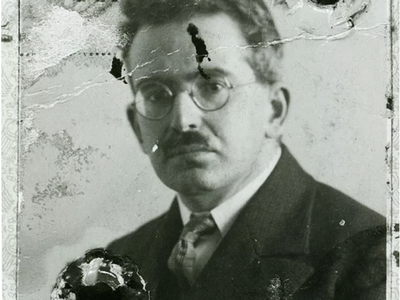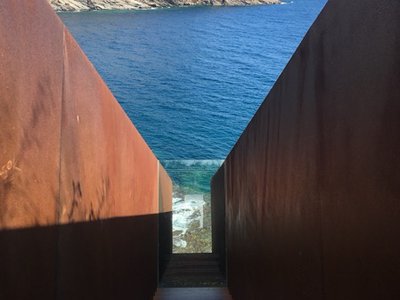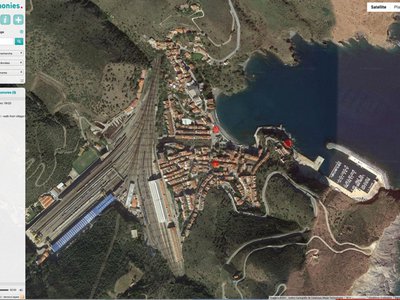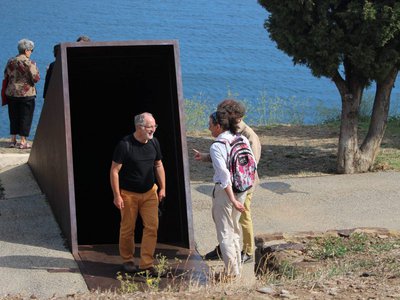"Chers invisibles" / "Dear invisibles"
Walter Benjamin wrote on radio and for the radio. In the late 1920s, he worked for public radio in Berlin and Frankfurt. He loved the popular dimension of this new media with endless possibilities, including that of staging everyday life. In particular, he has produced a series of programs “for children”, which are equally aimed at adults. The radio was for Benjamin the place par excellence of practical application of his reflections on the means of technical reproducibility. He even sketched a theory of radio. We propose to revisit Benjamin's writings and radio plays to question the uses and potentials of radio today as part of our research group.
How the world sounds: temporal dimensions of the perception with Walter Benjamin works that took place around Memorial of Walter Benjamin at Portbou - an event, delocalized for 2 days at Portbou where every 2 years a meeting around Walter Benjamin’s work is gathering researchers, artists, architects and philosophers to debate and experiment his work. This meeting questions the relation between the sound and the philosophy: Walter Benjamin, the radio and the Childhood.
Recordings
These are the recordings of the seminar „Walter Benjamin, la radio et l’enfance / Walter Benjamin, Radio and Childhood, held in Portbou, Spain, September 29-30th, 2021)
- Sound installation > Radio Wega (Giuseppe Gavazza)
An introduction walk through the installation on the seashore, while the participants to seminar meet up & have a drink at "Antonio’s" - "A l’écoute" de Walter Benjamin (a lecture by Didier Tallagrand)
- "Chers invisibles" / “Dear invisibles” #1 (introduction by Nicolas Tixier)
- Walter Benjamin et la radio (diffusion) (Philippe Baudouin)
Excerpt from "Walter Benjamin, the collector of sparks", radio documentary by Philippe Baudouin broadcast on December 17, 2011 on France Culture, as part of the program "Une vie, une oeuvre". - "Dressez l’oreille, vous risquez d’en avoir besoin". Apprentissage de l’insatisfaction (a lecture by Anne Roche)
Between 1929 and 1933, Walter Benjamin produced about ninety broadcasts, talks for children, Hörspiele, Hörmodelle, radio games, literary conferences. On a selection taken from Lumières pour enfants and three radio plays, I propose to examine the interest he takes in this new medium of radio, some of the subjects he deals with, and the main modalities consideration of the medium – as opposed to the classic lecture: questioning the audience, by appealing to common experiences, periodic reminder of the distance between the listener's reality and the fiction offered to him, exploration of "the various ways in which the fictional narrative can step over its own thresholds” (Gérard Genette), research on sounds drawn from everyday life, and on the expressiveness of voices. The purpose is to awaken the critical conscience of the listener, and to question the traditional separation between producer and consumer of cultural goods. - Walter Benjamin et Portbou (a lecture by Bruno Queysanne)
- Marche vers le mémorial W. Benjamin (a guided walk with Bruno Queysanne)
- Archéologie des « Hörspiele » en contexte allemand (Hans Hartje)
In my communication I propose a panorama of the technological, political, societal, ideological and aesthetic conditions of the emergence of a radiophonic art in the 1920s in Germany. Keywords: radio, Hörspiel, acoustic art, 1920s, Germany - En partant du narrateur : devenir des récits terrestres (Jean-Paul Thibaud)
Attempt at a short tale based on Walter Benjamin and his reflections on the story. What if we now had the task of learning to speak the language of the Earth? Keywords: storyteller, sensitivity, ecology, life, Earth - Electronic media and listening commons in the early years of Radio Ljubljana (Rajko Muršič)
- RadioWalk for Benjamin (Pavlica Bajsic Brazzoduro)
A treasure-hunt based format in a production inspired by Walter Benjamins writings. The collaboration of our team member and artistic director Pavlica Bajsic Brazzoduro and AAU_CRESSON / ENSAG project partner started at the winter school in Grenobleu where she presented her research and the Radiowalk, a new format created by merging of a soundwalk and a theatre performance. Due to COVID restrictions this participation and presentation were only possible because they took place online. But it also intensified the communication and collaboration between the project partners RadioTeatra and AAU_CRESSON / ENSAG. It resulted in September 2021 in Portbou, a small port on the border of France and Spain, where Pavlica Bajsic Brazzoduro presented an artistic production in memory of Walter Benjamin who died there running away from the Nazis. It is a radiowalk format dedicated to him and his writings for radio and for children. In its form, a radiowalk is based on the children’s treasure hunt and is therefore inspired by children and their responses and Benjamin´s writings for children are thematically very intriguing for this format. - "Le Mississippi et l’inondation de 1927" de Walter Benjamin (lecture par Sonia Pérez)
- "Chers invisibles" / “Dear invisibles” #2 (Nicolas Tixier)
- Navigating Borderscapes and Belonging. Memories of Children’s Radio Listening in Finland (Helmi Järviluoma- Mäkelä)
- Enfance et réalité à venir (Alexandre Costanzo)
It is first a question of exposing several figures of childhood which coexist in the work of Walter Benjamin, by privileging some which are sometimes left aside, to consider an overall situation from which it becomes allowable to put in tension thought of the history, reality, policy of emancipation. (47min 31) - The end of an era (correspondence of Benjamin and Adorno) / Sound Walk (Dana Papachristou and Georges Samantas)
“The end of an era” is an audio-walk composition based on the correspondence of Walter Benjamin with Gretel Karplus (later, Gretel Adorno) and Theodor Adorno, 1933-1940. The audio-walk is a geo-located composition based on the locative media platform Echoes.xyz. Excerpts from the extensive mail correspondence, together with fragments of their literary influences in spoken word, are composed in an itinerary that links together various milestones in Portbou, where Walter Benjamin’s legacy dwells vividly, as his last place of residence. - SoundWalk in & Out (sound walk by Dana Papachristou and Georges Samantas)
Recorded through the ears of Cédric Pichat & mixed with a parallel recording of the surrounding city life. - Experimental Broadcasting and Transnational Evening of Sounds (Heikki Uimonen)
Finnish Broadcasting Company’s live programme called Äänien ilta (Evening of Sounds) with approximately 200 000 listeners consists of callers’ narratives on their personal experiences and memories on contemporary and historical sonic phenomena from urban, agricultural and natural settings. Sound requests are fulfilled with the help of public service radio sound archives and present-day soundscape recordings. The show is broadcast with the help of a show host and visiting scholars representing research of environmental sounds, sound art and/or sound design. This paper studies the cultural, social and aesthetic nature of the sound requests hypothesising them being parallel to those of music call-ins in sharing music and experiences related to them. This is enabled by the radio listeners’ soundscape competence, referring to the ability to interpret sounds of a given cultural background. Theoretically, the programme and the electro-acoustic community it is constructing, will be approached with the help of the concept of radiogenic content. The term is used to describe texts ideally suited to radio or the ones that utilize the distinctive qualities of radio and aesthetic use of sound. The paper is historically contextualised to Dziga Vertov’s and Paul Hindemith’s radiogenic experiments and reportages in the 1920s and further elaborated to construct B-Air-inspired programme European Evening of Sounds. - Sound performance – Radio Wega (Giuseppe Gavazza)
- Contes radiophoniques. Cinq contes lus par des enfants de l’école de Portbou mis en situation radiophonique
- Round table / Table ronde
- Lecture transversale et échanges finaux (Pascal Amphoux)
- Radio Benjamin at AAU Cresson
- Radio Benjamin Catalogue at AAU Cresson
See also: Radio Wega
Participants
Didier Tallagrand is an artist & teacher at Anncy high shool of arts
Nicolas Tixier is an architect, teacher at Grenoble high shool of architecture & at Anncy high shool of arts. Director of research laboratory Ambiances-Architectures-Urbanities: AAU-Cresson
Anne Roche is a professor emeritus in modern literature at the University of Aix-Marseille. She was awarded the Walter Benjamin Prize in 2018 for her book « Exercices sur le tracé des ombres. Walter Benjamin », published by chemin de ronde in 2010.
Bruno Queysanne is a sociologist. For 36 years at the Grenoble School of Architecture he taught sociology and then the history and philosophy of architecture. After his retiring in 2006, he continued his research activity by coordinating a multidisciplinary study on the Walter Benjamin Memorial by Dani Karavan in Portbou. During the meeting on "Walter Benjamin, the radio and childhood" he was in charge of presenting Benjamin's presence in Portbou at the time of his tragic death at the end of September 1940,
Hans Hartje is a teacher in general and comparative literature at the University of Pau. His favourite subjects include sound art as practised in German broadcasting, where the word 'Hörspiel' was even coined to designate a genre that is properly radiogenic.
Jean-Paul Thibaud is a sociologist, director of research at laboratory Ambiances-Architectures-Urbanities: AAU-Cresson. Is current research « SENSIBILIA » focuses on Sensitive approaches to think about the transformations of living environments.
Giuseppe Gavazza is a composer, teacher at the Conservatory of Cuneo and researcher at the AAU-Cresson laboratory. He is an organizer of contemporary music, in the field of AST (Art, Science, Technology) and musical theatre for children. His compositions have successfully participated in international competitions, are published, recorded and broadcast internationally.
Pascal Amphoux is an independent researcher developing activities as a practitioner and consultant on numerous architectural, urban and/or environmental projects. Author of numerous books and scientific publications on the sound and urban environment, and more specifically, on the relationship between project practice, landscape aesthetics and social science methods.
Sébastien Depertat is is a doctoral student at the AAU-Cresson laboratory. His research focuses on listening and sensitive approaches to environments in the Anthropocene era.
Cédric Pichat is a research engineer at the AAU-Cresson laboratory. His mission is to support researchers in their projects through the management of experimental devices and associated sensors, in environmental and sensitivity measurement campaigns, and in methodological development needs.
Children of the Sant jaume primary school, under the lead of Ferrana Roldan Laguna, Director; Lucía Pina Mora reads Què valent! by Lorenz Pauli, Mikala León Salinas reads Habría que… by Thierry Lenain, Cloe Jurado Santacruz reads L’estel by Rachel Hausfater-Douïeb, Alexia Mackiewiz Rodríguez reads La comtessa by Quermançó – légende, Israe Rhayt reads Le corbeau et le renard – Aesop's Fable
Rajko Muršič is Professor of Ethnology/Cultural Anthropology at the University of Ljubljana, Faculty of Arts, Dept. of Ethnology and Cultural Anthropology. His research focuses on anthropology of popular music, theories of culture, epistemology, urban anthropology, methodology of anthropological research, sensory studies, etc. He participates as expert researcher in the ERC project Sensotra (Sensory Transformations and Transgenerational Environmental Relationships in Europe, 1950-2020) at the University of Eastern Finland (2016-2021), and B-Air (Art Infinity Radio – Creating Sound Art for Babies, Toddlers and Vulnerable Groups) led by the Radio Slovenia.
Pavlica Bajsic Brazzoduro is an author, dramaturg and director who has been active in radio, theatre and film since 1995. She received MA in dramaturgy at the Academy of Dramatic Arts in Zagreb and in aesthetics at Paris. She lives in Zagreb and Berlin.
Sonia Pérez est responsable de la coordination à l’école supérieure d’art Annecy Alpes.
Helmi Järviluoma-Mäkelä is a Finnish sound, music, and cultural scholar and writer. She is a Professor of Cultural Studies at the University of Eastern Finland. As sensory and soundscape ethnographer, Järviluoma has developed the mobile method of sensobiographic walking. Her research and art spans the fields of sensory remembering, qualitative methodology (especially regarding gender), environmental cultural studies, sound art and fiction writing. Alexandre Costanzo vit à Paris et enseigne la philosophie à l’école supérieure d’art d’Annecy. Cofondateur de la revue Failles, il est auteur de divers essais concernant les logiques de l’émancipation.
Dana Papachristou is a musicologist and artist that focuses on the combination of artistic genres with new media. She studied music (piano, clarinet, composition) in Elliniko Odeon, musicology in the University of Athens, and Music Culture and Communication in the department of Music Studies, delving into “the relation of music and painting within Modernism, through the correspondence of Shoenberg and Kandinsky”. She holds a PhD on the “Aesthetics of New Technological Media Arts in Deleuze’s and Guattari’s Anti-Oedipus and Milles Plateaux”. In the last few years she has participated in interdisciplinary research endeavors on contemporary music and its relation to other art genres, in various musical and geo-located projects, and has worked as a music teacher in primary education. She is a founding member of akoo.o group, with which she engages in the composition of soundwalks and audiowalks with the use of locative media. She is currently teaching in Thessaly University, in the dept. of Culture, Media and Creative Industries, while she is also a visiting scholar in Californian Institute of the Arts (CalArts).
Yorgos Samantas is a social anthropologist specializing in sound, hearing and walking as cultural practices and as artistic media. He has conducted long-term ethnographic researches in Athens and in Andros island, and numerous minor ones in Manchester, UK, and in Greece focusing on youth subcultures, culture and the environment, migration, mental health, and art in the city. He has participated in conferences, exhibitions and festivals in Greece, UK, Scotland, Albania, Slovenia, Belgium, and Germany, both as a researcher-ethnographer and as an artist. He has been a member of transdisciplinary projects between art and social science (Fonés, akoo.o, learning from documenta, spaces of reflection) engaged on projects on sound, hearing and walking, and art out of the white cube. He has worked as a sound designer and editor for ethnographic films, theater and dance performances, a field-recordist, scientific editor for the radio, art mediator and educator, and a dj. He is currently a member of TWIXTlab, a project between anthropology, contemporary art the everyday life, and works on fields between visual and sound art, education and anthropology.
Heikki Uimonen (PhD) holds a post of research director at the University of Eastern Finland. He is an ethnomusicologist and a docent on acoustic communication and soundscape studies at the Universities of Tampere and Eastern Finland and part-time musician. Uimonen has published articles, a monograph and edited anthologies on music consumption, radio music, compact cassettes and changing sonic environments. His research interests include sonic construction of place, mediated music, social use of music, transforming soundscapes and how all these intertwine.
juL McOisans (Technical radio staff) Studied educational sciences in the early 80’s & musicology in the late. After professional experiences in graphic design and telematics, he integrated the Cresson laboratory, in charge of the publications and of the valuation of the research. The specificity of this one, focusing on the sound environment, brought him to lead diverse experiments on the whole audio process : from the in situ recording, to the processing & editing and to the distribution & broadcasting (supports, media, installations…).
Creative Team
General coordination Nicolas Tixier
with Pascal Amphoux, Pavlica Bajsic Brazzoduro, Philippe Baudouin, Alexandre Costanzo, Sébastien Depertat, Giuseppe Gavazza, Hans Hartje, Helmi Järviluoma- Mäkelä, juL McOisans, Rajko Muršič, Dana Papachristou, Sonia Pérez, Cédric Pichat, Bruno Queysanne, Anne Roche, Yorgos Samantas, Didier Tallagrand, Jean-Paul Thibaud, Heikki Uimonen, & Children of the Sant jaume primary school.








